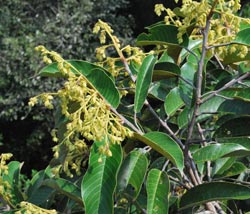Drought makes Borneo’s trees flower at the same time

The study species, Shorea beccariana <br>Picture: UZH <br>
Evolutionary biologists from the University of Zurich have identified two genes that indicate when the plants are about to flower. By monitoring these genes specifically, scientists are better able to predict when mass flowering will occur. This means that plant seeds can be collected in a targeted manner and used for reforestation.
Tropical plants flower at supra-annual irregular intervals. In addition, mass flowering is typical for the tropical forests in Borneo and elsewhere, where hundreds of different plant timber species from the Dipterocarpaceae family flower synchronously. This phenomenon is all the more puzzling because both temperature and day length are relatively constant all year round due to geographical proximity to the equator. Up to now it was supposed that several weeks of drought may trigger mass flowering in Borneo's forests. However, no empirical data and genetic analyses were available.
An international research team headed up by evolutionary biologists at the University of Zurich has now identified two genes responsible for the flowering of a tropical deciduous tree species Shorea beccariana. After drought periods, the two genes SbFT and SbSVP undergo dramatic transcriptional changes directly before flowering. The researchers can also confirm the flowering functions of these two genes using transgenic Arabidopsis thaliana plants.
85-meter canopy crane necessary for sample collection
The PhD student Masaki Kobayashi, his supervisor Professor Kentaro Shimizu and their Malaysian, Taiwanese and Japanese colleagues collected multiple buds from a single Shorea beccariana tree shortly before the start of flowering. “Given the fact that Shorea is a giant tree, having its crown at 40 meters of height, this sample collection was not easy at all”, says Shimizu. Only with the help of an 85m high canopy crane were they able to collect samples at six different time points over a two-year period. Next, they analyzed the sample material using a next-generation sequencing procedure, which was initially developed for human genome and disease research. In this way, Kobayashi and Shimizu identified 98 genes that are associated with the flowering of the plant – including the genes SbFT and SbSVP, which showed transcriptional changes after a drought period and directly before flowering. The scientists then combined their genetic results with the meteorological data of the region. Kobayashi concludes that «Flowering in Shorea beccariana is triggered by a four-week drought in combination with elevated sucrose levels.»
Toward prediction of mass flowering
Climate change will affect the frequency of drought periods and is thus predicted to affect also the frequency of mass flowering. Environmental protection and restoration of the forests have so far been severely hindered by the irregularity of the mass flowering intervals, which are thus difficult to predict. It was never possible to know when the seeds needed could be collected. The genes that have been identified now indicate when mass flowering is about to happen. «Successively monitoring of gene activity can help predict when mass flowering will take place», explains Kobayashi. This will make it possible to coordinate the collection of seeds and improve biodiversity and conservation programs substantially. Kentaro Shimizu and his colleagues will continue to explore these interactions in the newly created University Research Priority Program «Global Change and Biodiversity» at the University of Zurich.
The research was supported by the University Research Priority Programs in Global Changes and Biodiversity, in Systems Biology / Functional Genomics, and SystemsX.ch.
Literature:
Masaki J. Kobayashi, Yayoi Takeuchi, Tanaka Kenta, Tomonori Kume, Bibian Diway, Kentaro K. Shimizu. Mass flowering of tropical tree Shorea beccariana was preceded by expression changes in flowering and drought responsive genes. Molecular Ecology. May 8, 2013. doi: 10.1111/mec.12344
Contact:
Prof. Kentaro K. Shimizu
Institute of Evolutionary Biology and Environmental Studies
University of Zurich
Phone: +41 44 635 67 40 or 49 70
E-mail: kentaro.shimizu@ieu.uzh.ch
Media Contact
More Information:
http://www.uzh.chAll latest news from the category: Life Sciences and Chemistry
Articles and reports from the Life Sciences and chemistry area deal with applied and basic research into modern biology, chemistry and human medicine.
Valuable information can be found on a range of life sciences fields including bacteriology, biochemistry, bionics, bioinformatics, biophysics, biotechnology, genetics, geobotany, human biology, marine biology, microbiology, molecular biology, cellular biology, zoology, bioinorganic chemistry, microchemistry and environmental chemistry.
Newest articles

Properties of new materials for microchips
… can now be measured well. Reseachers of Delft University of Technology demonstrated measuring performance properties of ultrathin silicon membranes. Making ever smaller and more powerful chips requires new ultrathin…

Floating solar’s potential
… to support sustainable development by addressing climate, water, and energy goals holistically. A new study published this week in Nature Energy raises the potential for floating solar photovoltaics (FPV)…

Skyrmions move at record speeds
… a step towards the computing of the future. An international research team led by scientists from the CNRS1 has discovered that the magnetic nanobubbles2 known as skyrmions can be…





















